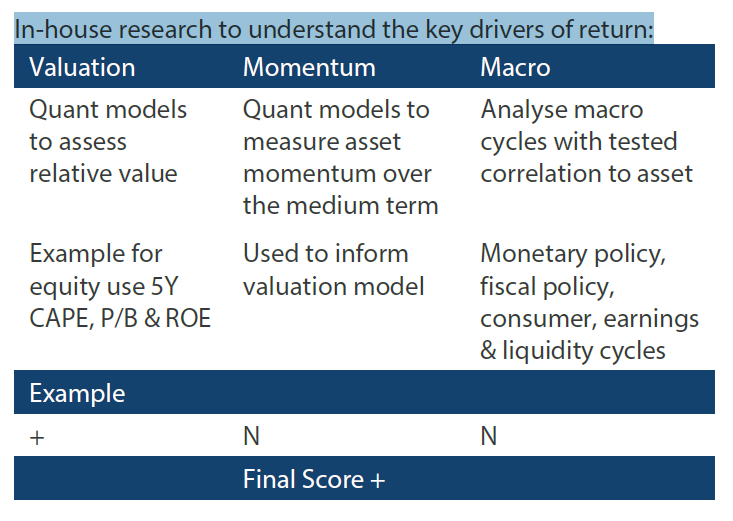Snapshot
Cross-asset pricing has recently been challenging our reflationary outlook. When we first discussed the prospects for reflation about a year ago, we identified a number of key factors. Top of the list was the substantial and synchronous monetary and fiscal stimulus combined with an eventual reopening of the economy that would be very positive for growth. We expected activity to rebound strongly coming out of the original lockdowns and then to be reinforced with vaccines and even more fiscal stimulus from the US following the “blue wave” elections. As these factors began to play out, reflationary positioning performed very well through the first quarter of this year.
The second quarter started with a pause in the upward momentum for yields, which had risen sharply in the first quarter on a reflationary consensus following the ultra-low rates in the darkest days of the pandemic. Many cross-asset price movements have also reversed course, including a return to global rates compression, a stronger dollar and a rotation from value back to growth. These reversals could simply indicate that profit takers have moved in after some successful trades, or more worryingly, the changes could be foreshadowing a more disappointing growth scenario. There is little doubt that price pressures have been running hot but a breakdown of the components driving recent inflation indicate that much of it seems more driven by supply disruption than sustained higher demand. This weighs against persistent inflationary pressures but also, to some extent, the argument for reflation.
The combination of monetary and fiscal stimulus, unprecedented in terms of size and scope, has been effective in supporting economies through the worst of the pandemic. However, emergency government policies in themselves do not create sustainable demand and growth because of their inherently temporary nature. At some point, organic growth needs to retake the lead in the shadow of the pandemic as government policies are gradually reduced. Have we turned negative on growth? No, but we do believe that the world has yet to come to the realisation that demand patterns may not return to a sense of normalcy for some time, which is why we adjust our outlook for potential volatility ahead.
Over the last decade, markets seemed almost trained to believe in binary outcomes contingent on stimulus being added or removed, however slowly. This makes some sense following the Global Financial Crisis (GFC) given the extent of systemic damage that did require a more prolonged stimulus programme. This time around, the financial system is healthy and spreading growth has the potential to be more self-sustaining. Of course, the path toward that end will not be easy with spikes in volatility virtually guaranteed, and while we remain cautious on this front, the growth outlook remains quite positive, in our view.
Cross-asset1
We downgraded our view on growth assets to neutral, after having been overweight for some time, while also lifting our view on defensive assets to just slightly negative. We are still fundamentally constructive on global growth prospects but expect the period ahead to be more challenging as the world comes to terms with a pandemic that is proving difficult to vanquish, even as vaccinations grow rapidly. Our reflationary view has been premised on extraordinary monetary and fiscal stimulus supporting the global economy through the worst of the pandemic and then leading to a successful vaccine-driven reopening. The eventual release of pent-up demand and excess savings would lead to exceptional growth—and possibly inflation.
However, increasing uncertainty surrounding consumers’ willingness to spend in the face of the new Delta variant may delay a return to more “normal” patterns of demand. Potentially weaker demand in Asia as China’s credit impulse turns negative may also be a headwind. As a result, the “reflation trade” that we have championed for the last year is less clear cut and potentially losing traction. We have reduced our view on developed market (DM) equities and listed infrastructure while lifting our view on higher income growth assets such as emerging market (EM) bonds and high yield. We also reduced our view on inflation assets and, to a lesser extent, our investment grade (IG) credit, in turn upgrading our view on DM sovereign bonds.
1The Multi Asset team’s cross-asset views are expressed at three different levels: (1) growth versus defensive, (2) cross asset within growth and defensive assets, and (3) relative asset views within each asset class. These levels describe our research and intuition that asset classes behave similarly or disparately in predictable ways, such that cross-asset scoring makes sense and ultimately leads to more deliberate and robust portfolio construction.
Asset Class Hierarchy (Team View1)
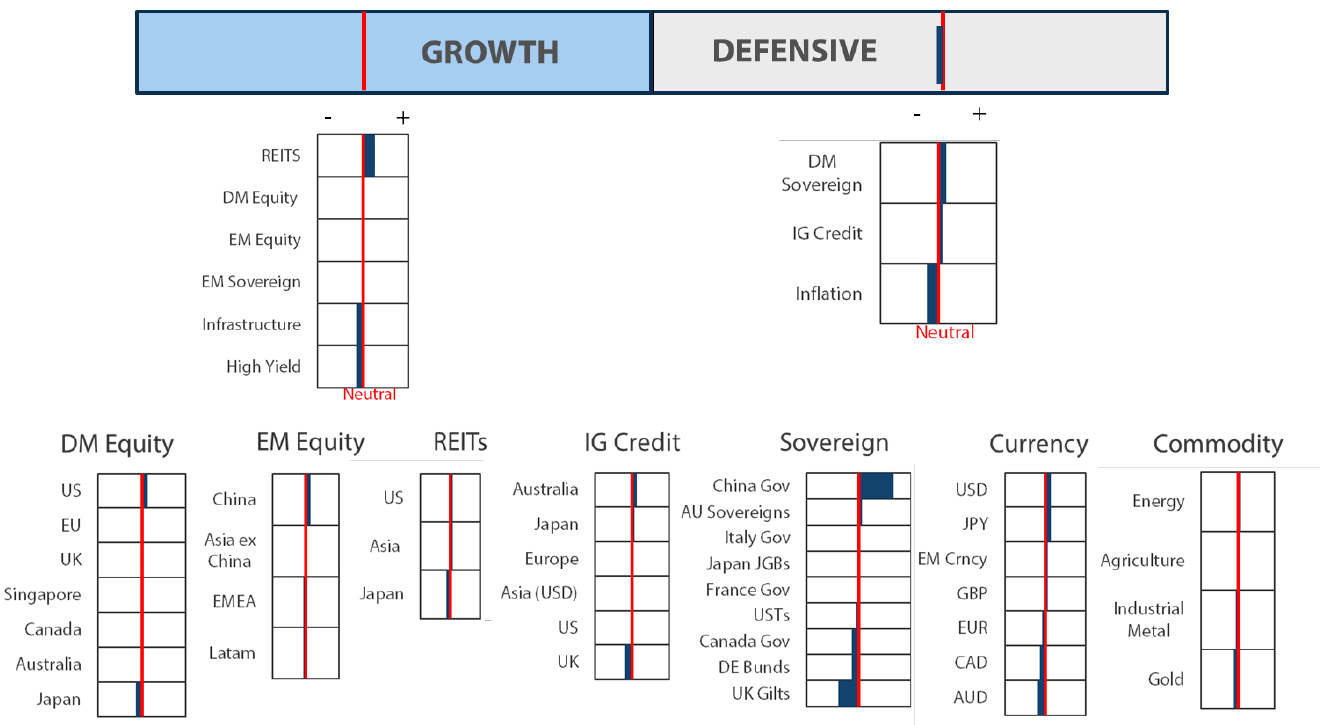
1The asset classes or sectors mentioned herein are a reflection of the portfolio manager’s current view of the investment strategies taken on behalf of the portfolio managed. The research framework is divided into 3 levels of analysis. The scores presented reflect the team’s view of each asset relative to others in its asset class. Scores within each asset class will average to neutral, with the exception of Commodity. These comments should not be constituted as an investment research or recommendation advice. Any prediction, projection or forecast on sectors, the economy and/or the market trends is not necessarily indicative of their future state or likely performances.
Research views
Growth assets
The thesis for reflationary growth is driven by a cyclical increase in demand where the US consumer remains critically important. Given the large amounts of stimulus to date and the sense that COVID-19 would present more of a pause than a structural headwind, reflationary growth had been a high conviction outcome. This has largely played out as predicted, but as US consumers have begun to tighten their belts—both for the waning stimulus-driven release of pent-up demand and renewed concerns for the Delta variant, the reflationary outlook is less certain.
Importantly, consumers reacted to higher prices driven by supply chain bottlenecks and higher demand. University of Michigan surveys show that higher prices are reducing plans for future purchases of housing and vehicles. Naturally, consumers would rather not pay for items that cost significantly more just months ago, but it also demonstrates that consumers lack visibility for future income prospects, and are perhaps happier to keep excess savings intact rather than spend in light of uncertainty.
Small businesses are not much different. With record low interest rates, plentiful liquidity and generous fiscal packages, one could have imagined strong prospects for a capital expenditure (capex) boom. However, just as demand remains cautious, so is investment—banks are reporting large increases in deposits but only tepid loan demand. The small business capex plan is far from upbeat.
No doubt, the rapid spread of the Delta variant is contributing to the sense of uncertainty. While we can take comfort that vaccines are protecting against hospitalisation and deaths, it is more difficult to say that we are firmly exiting the crisis. New restrictions in some countries—even among the vaccinated—is deflating hopes that COVID-19 will soon be behind us, which leaves future patterns of demand and investment still uncertain.
This is not to say that the recovery will completely stall, but it does reduce the trajectory which will have to be repriced into growth assets, where pockets may be fully priced. Value positions leveraged to reflationary growth are marginally less attractive, while “growth assets” such as technology could continue their dominance over value assets over the near-term. However, over the longer term, growth assets are also vulnerable to rising rates as the US Federal Reserve (Fed) nears the end of its cycle of extreme accommodation.
Revisiting US equity and earnings growth
US equity markets have a growth bias compared to other DM equities based on their sector composition. We often describe growth segments of the market as secular growth, meaning that they are less influenced by the economic cycle than structural factors such as technological disruption. For instance, the last decade witnessed growing digitalisation in daily life (e.g. online socialisation, e-payment and e-commerce) and working places (e.g. remote working, cloud computing, and industrial automation). Companies in growth sectors tend to have higher revenue/earnings projections, compared to value stocks.
While we typically describe cyclical versus secular growth themes, there is also a third category—defensives—that does not exhibit secular growth but is also less sensitive to the economic cycle. Think consumer staples, utilities and real estate. These characteristics are well illustrated by earnings per share (EPS) projections as shown in Chart 1. During 1H20, all sectors saw earnings downgrades in the depths of the COVID-19 pandemic. However, defensive sectors were much more resilient than cyclicals, while growth even accelerated, driven at least partly by stimulus and shifting demand focused on goods and working from home. Of course, while stimulus was plentiful and successful restrictions were followed by the promise of vaccines, EPS upgrades for cyclicals were quite significant in the second half of last year.
Chart 1: US Equity EPS Forecast 2020
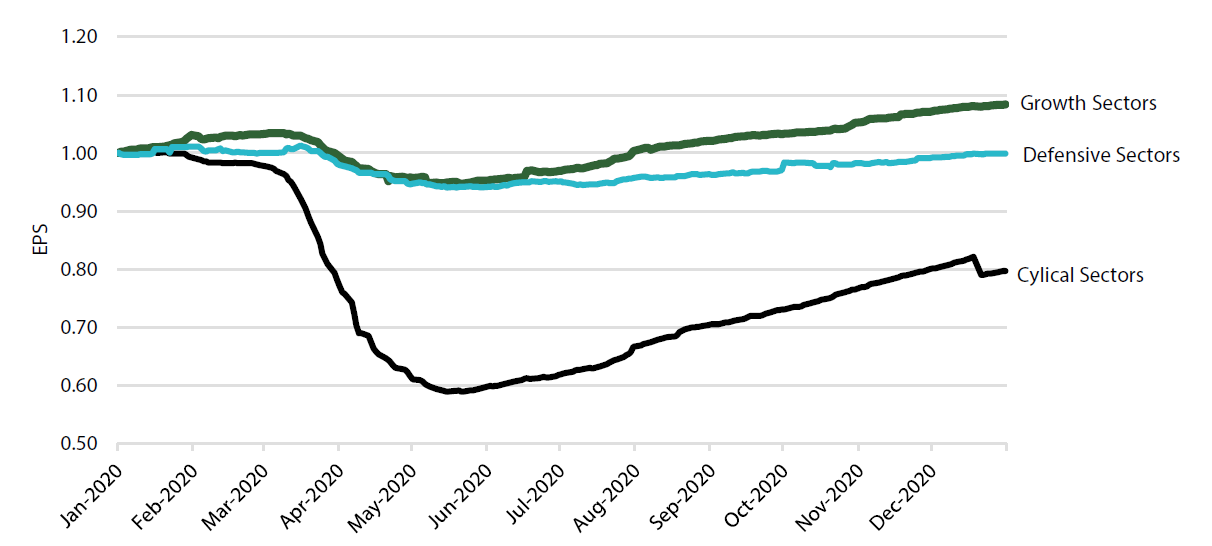 Source: Bloomberg, Nikko AM, August 2021
Source: Bloomberg, Nikko AM, August 2021
For 2021, cyclicals have experienced the strongest EPS upgrades, while growth has also fared quite well—again, partly driven by stimulus and the release of pent-up demand. As one would expect, defensives showed the least impressive upgrades.
Chart 2: US Equity EPS Forecast 2021
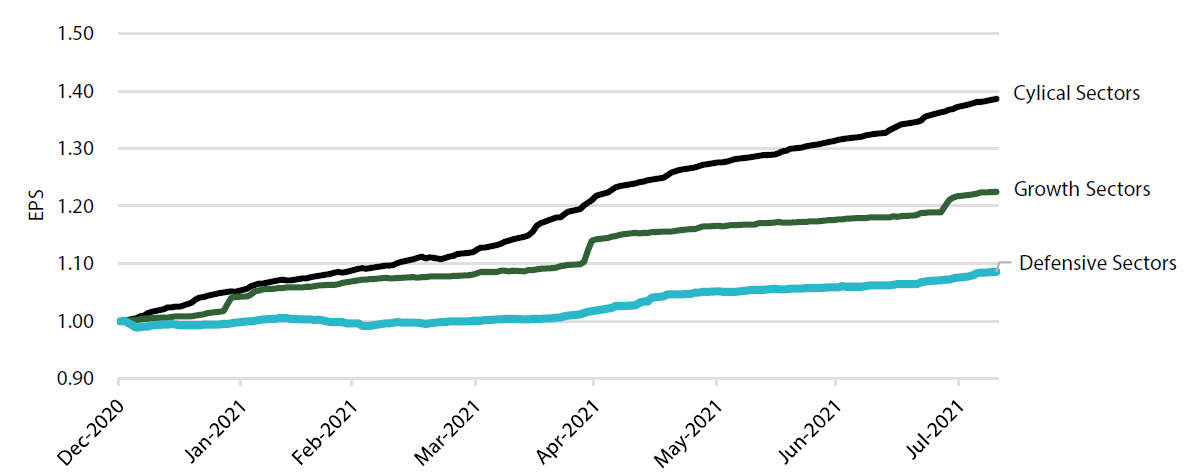 Source: Bloomberg, Nikko AM, August 2021
Source: Bloomberg, Nikko AM, August 2021
Earnings ultimately drive price over the long term, but the direction of rates is also a very important near-term driver of price in terms of the multiple that investors are willing to pay for future earnings. In Q1, rates lifted quite significantly, driving down the multiple on growth assets, while cyclicals fared much better because of their significantly smaller multiples and strong earnings prospects. Rates stabilised and then compressed in Q2, returning the preference for growth assets over cyclical value.
Moving forward, if cyclical growth moderates as we expect and rates begin to rise on expectations of central bank tightening, it makes us more cautious on equity assets in general where defensive exposures may prove more resilient than either growth or cyclical assets.
Conviction views on growth assets
- DM equities downgraded to neutral: Growth data has likely peaked both for the waning stimulus boost to demand and fresh headwinds driven by the Delta variant. We are still constructive on the continuation of the recovery. But given the strength of the rally to date against potentially negative surprises ahead, we believe a neutral position is more appropriate.
- Even prospects for growth versus value: Given the dynamic of slowing growth prospects, rates have compressed and growth has made a comeback. Our view is that given some of the headwinds, stimulus may fail to achieve the break-out trajectory required to support the reflation trade. Thus, we have increased our favourable view of the US where tech benefits from lower growth while reducing reflationary positions in Europe and Japan. We have also become more constructive on Australia and Singapore which tend to be more defensive.
- Adding to China:: The regulatory crackdown is concerning for fintech and e-commerce plays, but given the extraordinary valuation gap of the broader market relative to the rest of the world and authorities’ desire to tame but not kill the public markets, we added to China while marginally downgrading our views on EMEA, which is more vulnerable to negative surprise on global growth.
Defensive assets
Our view on defensive assets has improved marginally although we are still cautious. Global central bank policy continues to support economic recovery and remains in a highly accommodative state for now. While the time is approaching for officials to begin outlining a retreat from these policies later this year, the massive quantitative easing (QE) purchases continue to support global bonds. Consumer price pressures are evident in recent inflation releases although the jury is still out on whether this will have a lasting impact or prove to be mostly transitory. Altogether, we remain constructive on global bonds in the near term but remain on alert for any shifts in policy from the Fed.
Global credit spreads were barely changed over the month, but lower benchmark government yields once again helped deliver strong returns. Spread compensation for credit risk is at very low levels historically and leaves little room for any disappointments on managing the pandemic or less favourable economic outcomes. This leads us to temper our positive view on investment grade credit and take a more upbeat view again on sovereign bonds.
In this current episode of debt ceiling drama, the so-called “X Date”, the day on which the US government can no longer fulfil its financial obligations, is estimated to occur sometime in October or November this year. Although there is a lot of water to go under the bridge from now until then, the highly partisan nature of US politics is likely to take something that should be a routine legislative exercise and turn it into a potentially damaging spectacle for markets.
To be clear, we have been here before with two notable debt ceiling battles back in 2011 and 2013 which allows us to survey how markets reacted to each of these. Chart 3 shows how US equities and Treasuries reacted during the crisis in 2011. The X Date in this case was projected to be 2 August and a deal was struck to raise the debt ceiling on 31 July with only two days to spare. While a default was avoided, the credit-rating agency Standard & Poor’s had seen enough and downgraded the US government, taking away its long-held AAA rating a few days later. The equity market’s reaction was harsh, falling by 17% from the high in July over this period. However, Treasuries stayed true to their negatively-correlated role with equities and yields fell, perhaps surprisingly, as the uncertainty was directly related to the creditworthiness of US Treasuries themselves.
Chart 3: US equities and Treasuries in 2011
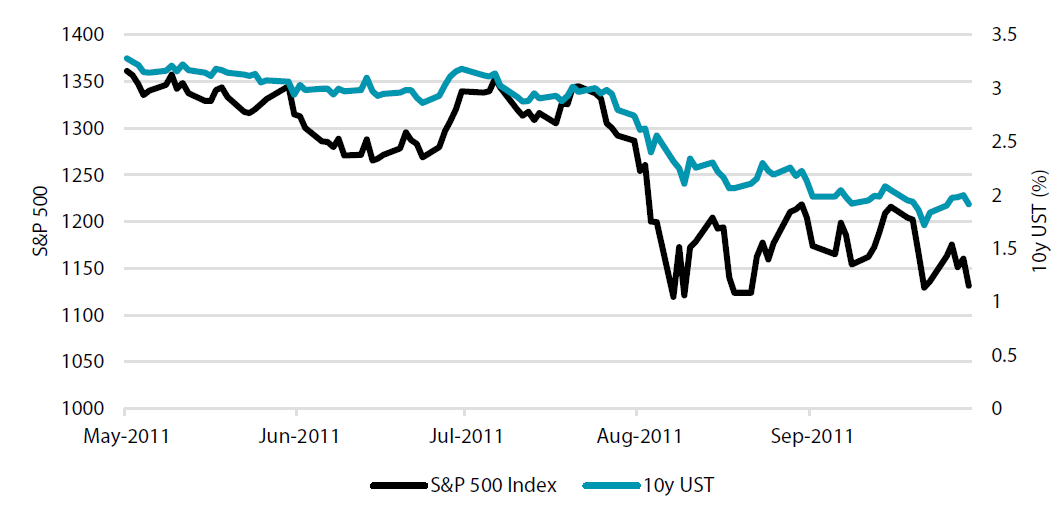 Source: Bloomberg, August 2021
Source: Bloomberg, August 2021
The debt ceiling showdown in 2013 took longer and had a few more twists and turns. Chart 4 shows how US equities and treasuries reacted during the crisis in 2013. This redux of debt ceiling politics began in January 2013 when the government reached its debt ceiling set at the conclusion of the 2011 negotiations. The initial response was to suspend the debt ceiling in February for three months such that the debt ceiling became fixed again in May with a longer-term solution still not agreed. Then began a period similar to the one the US is in right now where the ceiling was fixed, and the government was using extraordinary measures to carry on. The X Date in 2013 was also projected to be in October and it went down to the wire again before the debt ceiling was suspended finally in mid-October. While there were no subsequent credit-rating agency actions this time, the government went into a partial shutdown in early October to conserve funds and avoid a technical default. Unlike in 2011, equities maintained strong performance for most of this period (although with heightened volatility) and Treasuries weakened.
Chart 4: US equities and Treasuries in 2013
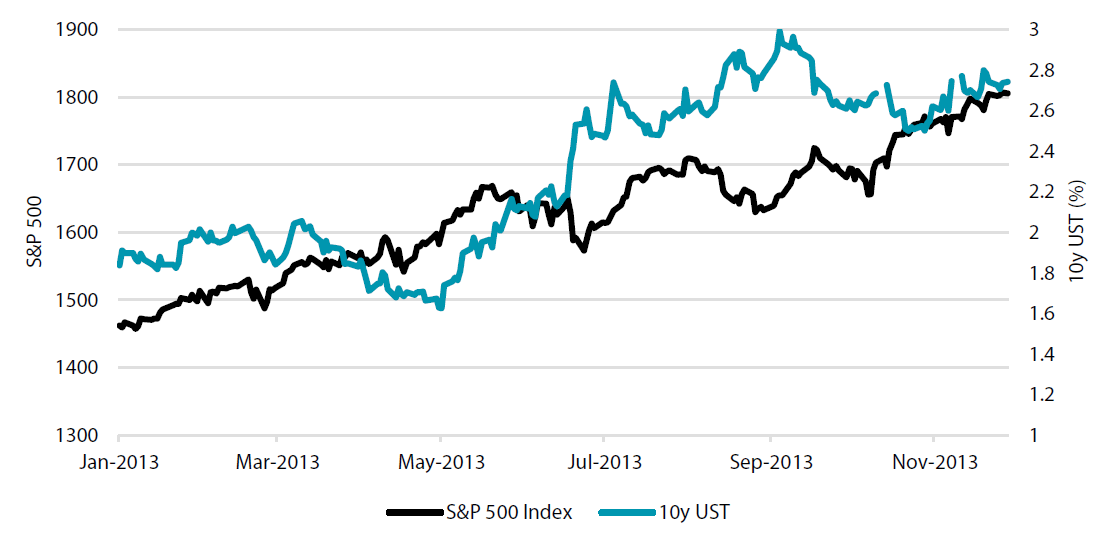 Source: Bloomberg, August 2021
Source: Bloomberg, August 2021
While the debt ceiling crises of 2011 and 2013 may be helpful in understanding the political strategies the two parties are likely to employ in 2021, market reactions were mixed and not very definitive. However, it does seem clear that equity markets reacted negatively in the weeks prior to the respective X Dates and political posturing was at its height. US Treasuries played their risk mitigation role during these bouts of equity weakness but yields also rose significantly during the May-October 2013 period when negotiations were ongoing. The parallels seem slightly stronger between this year and the 2013 crisis given the protracted drama that unfolded then and is occurring now. But once again it is not definitive, and the make-up of the US Congress is different now with the Democrats holding a majority in the House and the narrowest of majorities in the Senate. We expect this issue to be more of a sleeper for markets that will only rear its head as we approach October.
Conviction views on defensive assets
- China bonds still the pick of sovereigns: China’s government bonds offer higher yields and lower volatility than traditional developed market sovereign bonds and the recent reserve requirement ratio (RRR) cut may be the first step towards easier monetary policy.
- Shorten duration in dollar-bloc bonds: The Fed is closing in on a plan to begin tapering its bond purchases as numerous Fed officials begin to speak publicly in support of tapering this year.
Process
In-house research to understand the key drivers of return:
